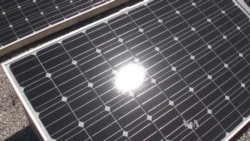Texas, a state known for oil production, has become a leader in the development and use of renewable energy, especially wind power. And solar energy production is growing rapidly in the “Lone Star state” spurred on by the state’s abundant sunshine and the sharp drop in the price of solar panels in recent years.
Kerry hails Texas research
Back in April, just after taking part in the signing of the Paris Climate Summit agreement in which world nations committed themselves to a concrete plan to reduce greenhouse gas emissions, U.S. Secretary of State John Kerry visited a University of Texas solar research site in Austin. He spoke of both the environmental and economic benefits of solar energy development.
“Millions of jobs will be created in the building of, and in the maintenance and running of, these kinds of energy production facilities,” Kerry said.
Kerry also met with some of the Texas business leaders and entrepreneurs who have developed both wind and solar energy resources, aided by the state’s investments in infrastructure. The state has invested in high-power lines to bring electricity from wind turbines in remote areas of west Texas to big urban centers in central Texas.
While Kerry and President Barack Obama encourage the development of renewable, clean energy sources to combat global warming, that issue has less traction in Texas. The conservative Republicans who control state government are skeptical of climate change, so their backing of renewables is all about cost.
The business of clean energy
One of the businessmen who met with Kerry, Michael Skelly of Cleanline Energy, said he expects state support for this growing segment of the Texas economy to continue.
“You will see, over the next five or 10 years, a lot more investment in the grid and that, too, will facilitate more solar generation,” said Skelly.
Another participant was Andy Bowman, chairman of Pioneer Green Energy, a company that has mostly focused on wind, but is now developing solar projects.
“A lot of wind companies have evolved to include solar and wind because solar has become so cheap. It is quite competitive with not only wind, but with fossil (fuel) generation,” Bowman told VOA.
Experts see shifts in energy sector
Jennifer Ronk, a renewable energy expert at the Houston Advanced Research Center, told VOA electrical energy production will increasingly involve a variety of energy sources. She said it makes sense for a new energy company to develop both wind and solar.
Wind is most active at night, “which is not when we have our highest usage," she explained. "So, to be able to put up some solar panels, which obviously produce more in the daytime, balances out the system a lot.”
One major goal of renewable energy developers has been to come up with a means of storing energy produced at times when there is slack demand so that it can be used at times when there is more need. Ronk said the research on developing better batteries for electric cars, computers and smartphones has helped the effort to build big batteries.
“There is a lot of research being done, a lot of development being done,” she said. “I think it is going to be interesting to see what happens in the next three to five years.”
Ronk said the use of coal is likely to decrease further in the years ahead in Texas and elsewhere, mainly because of cheaper and cleaner-burning natural gas. But she said it is unlikely that the electrical grid will be powered entirely by clean, renewable energy for many years to come.
“I don’t think the world is going to shut off all major power plants everywhere and run everything on solar. That’s not where we are going long-term,” she said. “I think there is a mix of solutions that are going to be the optimal outcome.”
She said use of natural gas for generating electricity will continue to be cost effective, but nuclear power is stalled. She said modern nuclear reactors could provide a lot of clean energy, but the costs and public fears of devastating accidents have reduced its appeal.








